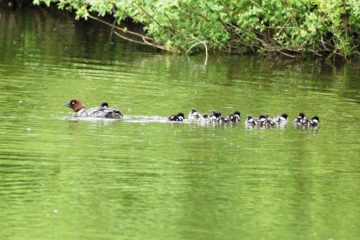Ringing at Howick Arboretum continued this month with 35 birds processed on the 3rd of August. These included 8 retraps with a female Great Tit first ringed in 2014 and another ringed in 2015 (both were already adults when first encountered). In the new birds were several very young Blackcaps; probably hatched locally. Several Willow Warbler were birds of the year but undoubtedly older and probably passing through on their way south to Africa. We also had some Swallows that looked like local birds who were fed up by ‘hawking’ for insects over the Cricket Pitch. Two very local juvenile Nuthatch completed the interesting catch. Ringing on the 4th was less productive as rain curtailed the session with only 19 birds captured but these provided two of this month’s photographs: They include a picture of two Swallows one a very ‘bright’ adult male and the other a paler juvenile. The second picture is of a Whitethroat; the first ringed at Howick. This will feed-up to add body fat and then depart probably to overfly northern France, heading for Iberia; then to Morocco and overflying the Sahara to spend the winter in Senegal, The Gambia or Chad. (See attached photos.)
Ringing on the 10th was also curtailed by rain but not before 22 birds were processed including a very loud Great Spotted Woodpecker (a female hatched last year) and other local residents such as Tits and Chaffinches. We did catch several Willow Warblers and Chiffchaffs but no sight was to be had of any Blackcaps; indicating that the ‘local’ birds had vacated the area to fly south. The 11th was more productive with 29 birds but again no Blackcaps. The ‘locals’ included a male Chaffinch first seen in 2015 (as an adult). Wind was a problem on the 17th with only 9 birds caught; although they included a surprise House Martin (remarked upon by those present for its beautiful feathery feet!). It was flying with the Swallows over the Cricket ground.
We were very busy on the 25th August with 71 birds processed including 45 retraps with a male Great Tit first ringed as a juvenile in 2013. Of the new ‘resident birds’ there was an adult female Greenfinch (a bit of a rarity on the site) and a single Long Tailed Tit (not usually scarce at Howick but a little so this year). The bad weather in the spring probably reduced their breeding productivity locally. A flock of foraging Goldfinch seem to have moved into the area along with a lot of young Blue Tits (that clearly had a much better breeding year than the Long Tailed Tits). Blue Tits naturally breed later than Long Tails (and often in boxes) so escaped some of the problems caused by the snow. Very young Chiffchaffs were still in the area but again no Blackcaps.
It was not until the 31st that Blackcaps seem to return to the area when a number were processed in a trawl of 73 birds. While all the Blackcaps were birds of the year they were well moulted displaying their adult head colours (Black for male; Brown for female) and almost certainly not local birds but birds from further north on their way south; to perhaps reach North Africa (they don’t usually cross the Sahara).

This is the time of year when I have to do quite a bit of paperwork (or rather computer work); sending Nest Records and the like to the British Trust for Ornithology. I started by reporting on our very own special (secret location) colony of breeding Goldeneye Ducks. This year the Goldeneye did quite well, with 11 separate nesting records of which 6 were successful in raising ducklings (see a picture of adult and brood). In addition, there was one nest which while not exactly successful – because a female Tawny Owl usurped the nesting duck – might be counted because entirely fortuitously
I and two trainees discovered a recently hatched duckling during the course of the monitoring effort. In total 106 eggs were laid and 62 young were counted on the water. Optimistically maybe 20 have made it to actually fly; with 3 being observed on one pool on the 22/8/18. The final surprise (when cleaning unhatched eggs out of boxes) was finding a pair of one-year-old Barn Owls roosting in a Duck box on the 22nd . It’s hardly suitable for Barn Owls to nest in and they certainly were not attempting to breed but maybe next spring they will find a more suitable home.
Anyone interesting in ringing is invited to get in touch. Regular ringing continues this month at Howick Arboretum, on most Friday and Saturday mornings, and continues until the first week in October.
Phil Hanmer ‘A’ Ringer/Trainer Natural History Society of Northumbria Ringing Group (Hancock Museum)
E-mail: tytoalbas@btinternet.com